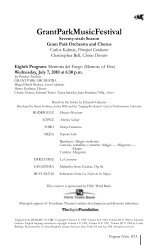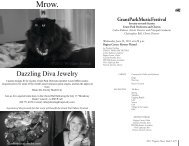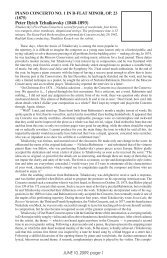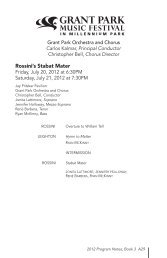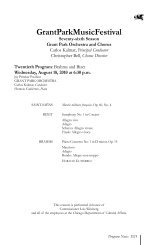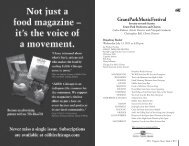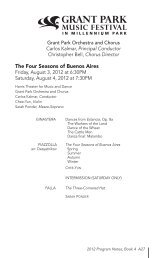Program Notes PDF - The Grant Park Music Festival
Program Notes PDF - The Grant Park Music Festival
Program Notes PDF - The Grant Park Music Festival
You also want an ePaper? Increase the reach of your titles
YUMPU automatically turns print PDFs into web optimized ePapers that Google loves.
Wednesday, August 3, 2011<br />
GRANT PARK MUSIC FESTIVAL<br />
mostly descending phrases. <strong>The</strong> orchestra takes over the main theme to provide a transition to<br />
the second subject, which is constructed from extensive elaborations of the rhythms and intervals<br />
inherent in the motto. A climax is built from this material in the development section before the<br />
recapitulation begins with roles reversed from the exposition: the upper strings play the main theme<br />
while the soloist hammers out aggressive permutations of the motto. <strong>The</strong> second subject is omitted<br />
in the recapitulation, but the violin reclaims the main theme in the coda, intoning it musingly<br />
above a sparse accompaniment of timpani, harp and plucked strings. <strong>The</strong> second movement is<br />
a driving, virtuosic, slightly sinister scherzo for which the more relaxed central section provides<br />
formal and expressive contrast. A brilliant cadenza that recalls the timpani motto and the main<br />
theme from the first movement serves as a bridge to the finale. <strong>The</strong> somber closing movement is<br />
a passacaglia, a formal technique using a series of variations on a short, recurring melody that was<br />
highly favored by Baroque composers but which fell into disuse with the changed requirements of<br />
the music of the Classical era. Britten fitted this passacaglia with nine variations on a stern scalar<br />
melody, and gave the music a serious emotional cast that seems to have reflected his sorrow over<br />
the horrors of the Spanish Civil War, which reached its bloody climax when he was completing<br />
the Concerto. “It is at times like these,” he said, “that work is so important — so that people can<br />
think of other things than blowing each other up! ... I try not to listen to the radio more than I can<br />
help.” Though Benjamin Britten was only 27 when he composed his Violin Concerto, the work<br />
shows that he had already become a master of reflecting the human condition in music of technical<br />
mastery and emotional depth.<br />
Symphony No. 1 in C minor, Op. 68 (1855-1876)<br />
Johannes Brahms (1833-1897)<br />
Brahms’ Symphony No. 1 is scored for pairs of woodwinds plus contrabassoon,<br />
four horns, two trumpets, three trombones, timpani and strings. <strong>The</strong> performance<br />
time is 45 minutes. <strong>The</strong> <strong>Grant</strong> <strong>Park</strong> Orchestra first performed this Symphony<br />
on August 15, 1937, with Hans Lange conducting.<br />
Brahms, while not as breathtakingly precocious as Mozart, Mendelssohn<br />
or Schubert, got a reasonably early start on his musical career: he had produced<br />
several piano works (including two large sonatas) and a goodly number of songs by the age of<br />
nineteen. In 1853, when Brahms was only twenty, Robert Schumann wrote an article for the widely<br />
distributed Neue Zeitschrift für Musik, his first contribution to that journal in a decade, hailing<br />
Brahms as the savior of German music, the rightful heir to the mantle of Beethoven. Brahms was<br />
extremely proud of Schumann’s advocacy and he displayed the journal with great joy to his friends<br />
and family when he returned to his humble Hamburg neighborhood after visiting Schumann in<br />
Düsseldorf, but there was the other side of Schumann’s assessment as well, that which placed an<br />
immense burden on Brahms’ shoulders.<br />
Brahms was acutely aware of the deeply rooted traditions of German music extending back not<br />
just to Beethoven, but even beyond him to Bach and Schütz and Lassus. His knowledge of Bach was<br />
so thorough, for example, that he was asked to join the editorial board of the first complete edition<br />
of the works of that Baroque master. He knew that, having been heralded by Schumann, his compositions,<br />
especially a symphony, would have to measure up to the standards set by his forebears.<br />
At first he doubted that he was even able to write a symphony, feeling that Beethoven had nearly<br />
expended all the potential of that form, leaving nothing for future generations. “You have no idea,”<br />
Brahms lamented, “how it feels to hear behind you the tramp of a giant like Beethoven.”<br />
Encouraged by Schumann to undertake a symphony (“If one only makes the beginning, then<br />
the end comes of itself,” he cajoled), Brahms made some attempts in 1854, but was unsatisfied<br />
with the symphonic potential of the sketches, and he diverted them into the First Piano Concerto<br />
and the German Requiem. He began again a year later, perhaps influenced by a performance of<br />
Schumann’s Manfred, and set down a first movement, but this music he kept to himself, and even<br />
his closest friends knew of no more than the existence of the manuscript. Seven years passed before<br />
2011 <strong>Program</strong> <strong>Notes</strong>, Book 4 D11



